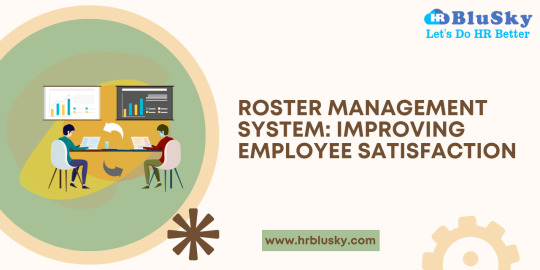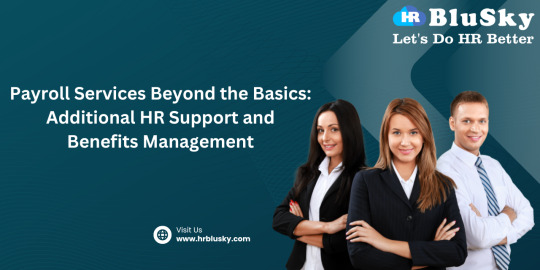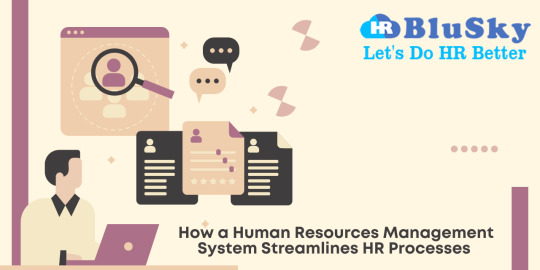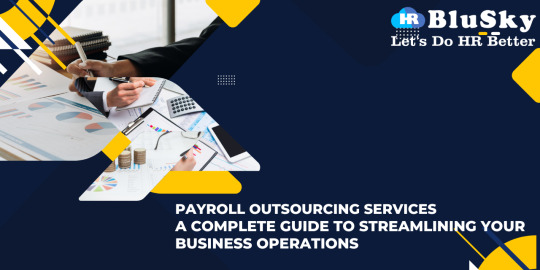Don't wanna be here? Send us removal request.
Text
Roster Management System: Improving Employee Satisfaction

In today's competitive business landscape, employee satisfaction is not just a nice-to-have; it’s a crucial factor for success. Companies that prioritize the well-being of their staff tend to see lower turnover rates, higher productivity, and a more positive workplace culture. One of the most effective ways to improve employee satisfaction is through an efficient roster management system. This blog explores how such a system can have a significant impact on employee morale and overall satisfaction.
Understanding Roster Management Systems
A roster management system is a tool that helps businesses schedule their employees effectively. It ensures that the right number of staff members with the right skills are available at the right times. This system can handle complex scheduling needs, accommodate employee preferences, and ensure compliance with labor laws. When implemented properly, a roster management system can be a game-changer for both employers and employees.
Benefits of a Roster Management System
1. Increased Flexibility
One of the primary advantages of a roster management system is the flexibility it offers. Employees today value work-life balance more than ever. A system that allows them to indicate their availability, request time off, and swap shifts with colleagues gives them a sense of control over their schedules. This flexibility can lead to higher job satisfaction as employees can better manage their personal and professional commitments.
2. Improved Communication
A good roster management system facilitates clear and consistent communication. Employees can receive updates about their schedules in real time, reducing the chances of misunderstandings and last-minute changes. Notifications about upcoming shifts, changes, or requests for overtime can be sent directly to their smartphones. This level of transparency ensures that everyone is on the same page, fostering a sense of trust and reliability.
3. Reduced Scheduling Conflicts
Scheduling conflicts can be a significant source of stress for employees. Double-booking, understaffing, or last-minute changes can disrupt not only the workplace but also employees’ lives. An effective roster management system minimizes these issues by providing a clear and organized schedule. It can automatically detect and alert managers to potential conflicts, allowing for timely adjustments and ensuring smooth operation.
4. Enhanced Fairness and Equity
A major source of dissatisfaction in many workplaces is the perception of unfair scheduling. Whether it's favoritism or simply a lack of consideration for individual needs, unfair practices can demotivate employees. A roster management system can help address these concerns by providing a transparent and impartial method of assigning shifts. By considering factors like seniority, skill level, and employee preferences, the system ensures a fair distribution of shifts, which can greatly enhance employee morale.
Implementing a Roster Management System
1. Assess Your Needs
Before implementing a roster management system, it’s essential to assess your company’s specific needs. Consider the size of your workforce, the complexity of your scheduling requirements, and the unique needs of your employees. This assessment will help you choose a system that best fits your organization.
2. Choose the Right System
There are numerous roster management systems available, each with its own set of features. Look for a system that is user-friendly, scalable, and capable of integrating with your existing HR and payroll systems. Key features to look for include real-time updates, mobile accessibility, and customizable scheduling options.
3. Involve Your Employees
Involving your employees in the implementation process can significantly improve the system’s acceptance and effectiveness. Seek their input on what features they find most useful and address any concerns they may have. Training sessions can help ensure that everyone understands how to use the system effectively.
4. Monitor and Adjust
After implementation, it’s important to continuously monitor the system’s performance and gather feedback from employees. Regularly review the scheduling data to identify any issues and make necessary adjustments. This ongoing process will help you refine the system and ensure it continues to meet the needs of your workforce.
Conclusion
Investing in a robust roster management system is a strategic move that can greatly enhance employee satisfaction. By providing flexibility, improving communication, reducing conflicts, ensuring fairness, and maintaining compliance, such a system addresses many common pain points that affect employee morale. As a result, businesses can expect to see a more engaged, motivated, and productive workforce. Ultimately, a happy workforce is a key driver of business success, making the implementation of a roster management system a wise investment for any organization.
0 notes
Text
HR Software Understanding Its Benefits and Choosing the Optimal Solution

Introduction
In today's fast-paced business environment, Human Resources (HR) departments play a crucial role in managing talent, fostering employee engagement, and driving organizational success. With the advent of technology, HR software has emerged as a powerful tool to streamline HR processes, improve efficiency, and enhance employee experience. In this comprehensive guide, we will delve into the various benefits of HR software and provide insights on how to choose the optimal solution for your organization's needs.
Benefits of HR Software
Improved Efficiency: HR software automates repetitive tasks such as payroll processing, leave management, and employee onboarding, saving valuable time for HR professionals to focus on strategic initiatives.
Enhanced Data Management: By centralizing employee data in a secure digital platform, HR software ensures accuracy, accessibility, and compliance with data privacy regulations. It eliminates the need for manual record-keeping, reducing the risk of errors and ensuring data integrity.
Improved Employee Engagement: HR software often includes features like employee self-service portals, performance management tools, and recognition programs, which empower employees to take control of their career development and foster a culture of continuous feedback and recognition.
Effective Performance Management: With HR software, organizations can set clear performance goals, track progress, and conduct performance evaluations more effectively. It facilitates ongoing communication between managers and employees, leading to improved performance and employee satisfaction.
Compliance Management: HR software helps organizations stay compliant with labor laws, regulations, and industry standards by automating compliance-related tasks, generating reports, and providing audit trails. This reduces the risk of legal penalties and ensures adherence to best practices.
Cost Savings: While there is an initial investment in implementing HR software, the long-term benefits often outweigh the costs. By streamlining processes, reducing administrative overhead, and improving productivity, HR software can lead to significant cost savings for organizations.
Choosing the Optimal HR Software Solution
Assess Your Needs: Start by identifying your organization's specific HR needs and objectives. Consider factors such as company size, industry, budget, and existing HR processes. This will help you narrow down your options and focus on solutions that align with your requirements.
Evaluate Features and Functionality: Look for HR software solutions that offer a comprehensive suite of features to support your HR processes. Key features to consider include onboarding, payroll processing, performance management, and reporting capabilities. Assess the user interface and ease of navigation to ensure user adoption and satisfaction.
Scalability and Integration: Choose a scalable HR software solution that can grow with your organization. Consider future expansion plans and ensure that the software can accommodate increased workload and user capacity. Customization and Flexibility: Opt for HR software that allows for customization and flexibility to adapt to your organization's unique requirements. Look for configurable workflows, customizable dashboards, and flexible reporting tools that can be tailored to meet your specific needs without extensive customization costs.
Cost Considerations: While cost is an important factor, it should not be the sole determinant in choosing an HR software solution. Consider the total cost of ownership, including implementation, training, support, and ongoing maintenance fees. Compare pricing plans, licensing options, and return on investment (ROI) to select a solution that offers the best value for your organization.
Conclusion
HRBluSky HR software offers numerous benefits for organizations seeking to streamline HR processes, improve efficiency, and enhance employee experience. By understanding the key features and considerations outlined in this guide, you can choose the optimal HR software solution that aligns with your organization's needs and objectives. Invest time in evaluating different options, conducting demos, and seeking input from key stakeholders to make an informed decision that will drive success for your HR department and the entire organization.
0 notes
Text
Payroll Services Beyond the Basics: Additional HR Support and Benefits Management

In today's dynamic business landscape, payroll services have evolved beyond simply processing employee salaries. They now encompass a wide range of HR support and benefits management functionalities, offering businesses comprehensive solutions to streamline their workforce management processes. In this article, we'll explore the various ways in which payroll services go beyond the basics to provide additional HR support and benefits management capabilities.
Employee Onboarding and Offboarding: Effective onboarding and offboarding processes are essential for maintaining employee satisfaction and ensuring compliance with regulations. Payroll services can assist with these processes by automating tasks such as new hire paperwork, tax form collection, and exit interviews. By streamlining these processes, businesses can save time and resources while providing a positive experience for employees.
Time and Attendance Tracking: Payroll services often include time and attendance tracking features, allowing businesses to accurately record employee hours worked and manage attendance policies. These tools can help businesses enforce attendance policies, track employee productivity, and generate accurate payroll reports based on time worked.
Benefits Administration: Managing employee benefits can be a complex and time-consuming task for businesses. Payroll services often include benefits administration functionalities, allowing businesses to manage employee benefits such as health insurance, retirement plans, and paid time off. These systems can automate benefits enrollment, track employee eligibility, and generate reports on benefit usage and costs.
Compliance Management: Staying compliant with ever-changing labor laws and regulations is a top priority for businesses. Payroll services often include compliance management features that help businesses stay up-to-date with federal, state, and local regulations. These systems can automatically calculate payroll taxes, generate tax forms, and provide compliance alerts for upcoming deadlines or changes in regulations.
Employee Self-Service Portals: Employee self-service portals are a valuable feature of many payroll services, allowing employees to access their payroll and HR information online. Through these portals, employees can view their pay stubs, update personal information, and manage benefits enrollment. By empowering employees to take control of their own information, businesses can reduce administrative overhead and improve employee satisfaction.
Performance Management: Some payroll services offer performance management features that allow businesses to track employee performance, set goals, and conduct performance reviews. These systems can help businesses identify top performers, address performance issues, and align employee goals with organizational objectives.
In conclusion, payroll services have evolved to offer much more than just paycheck processing. By providing integrated HR support and benefits management functionalities, payroll services help businesses streamline their workforce management processes, ensure compliance with regulations, and improve employee satisfaction. By leveraging these additional capabilities, businesses can focus on their core objectives while leaving the complexities of payroll and HR administration to the experts.
0 notes
Text
5 Tips for Remote Performance Management

At the heart of effective performance management is the need to establish an agreement between a supervisor and an employee about what is expected of a particular role and how to achieve this in practice. Amongst other things, it requires open communication, mutual respect, and clarity on goals and expectations.
Much of the traditional approach to performance management has revolved around observation, feedback, and face to face meetings, all supported by standard policies, procedures, and tools.
With the rise of remote working and social distancing, traditional performance management must be adapted to meet new challenges that have been added to this already complex blend.
The following are 5 tips to help you navigate performance managing an increasingly remote workforce:
1. Expect Performance Changes
For all the stories about how wonderful working from home has been and how productivity has increased, there are just as many about how difficult it is to balance work and home life, and how hard it has been to retain performance levels.
This is not a reflection of the attitudes of employees, but more of workforce diversity. For those who can set up a quiet home office, who have roles that lend themselves to be working remotely, and who haven’t dealt with the complications of home schooling alongside home working, maintaining productivity has been easier. Balance this against the employee who has no space to dedicate to an office set up, who may have several children at home requiring schooling support, and whose role requires significant interaction with others, and the dynamics are clearly very different.
Add to this the stresses of unnatural living conditions and additional health concerns brought on by the pandemic, and it is easy to see why many have struggled to maintain usual levels of productivity.
The bottom line is that everyone needs to accept that performance and productivity will have been impacted by the extreme circumstances everyone has been facing. More importantly, remote working is likely to be a norm for some time to come, and for others it may even be a permanent work state.
HR needs to work with managers and employees to develop a new set of procedures, policies, and systems support, and to re-calibrate performance standards for impacted roles. And this leads us to the second tip – the need to remain flexible.
2. Be flexible
The key to adjusting expectations and establishing what performance standards and goals need to be in place to drive the achievement of business goals, is to remain flexible.
What works for one individual or set of circumstances may not work for another, for all the reasons given above, and more.
Keeping a flexible approach and collaborating with employees to agree on practical working patterns, methods, goals, and deliverables is key to maintaining an engaged and productive workforce.
It should also be remembered that the need for flexibility must be two ways – essentially creating a culture of give and take, where both parties involved accept that they are working towards the same overall objective. There will be times when employees can set their own agenda, but equally times when getting a team together in a virtual meeting is critical to decision making.
An environment of mutual respect and trust is needed to achieve this level of flexibility.
3. Trust your employees
Maintaining performance whilst providing flexibility depends on trusting your employees.
For some time, there has been movement in the workplace towards reduced levels of management supervision. This has been driven by many different changes in working patterns, for example, the increasing implementation of agile project management which has seen self-driven and cross-functional teams directing their own work within agreed parameters.
Another factor has been the evolution of organization structures with flatter hierarchies, managers having a larger scope of responsibility, and correspondingly larger teams, often dispersed across various locations and even across different business streams.
In short, the increase in remote working has sped up the need for managers to let go of any tendencies to micro-manage, and instead to move their role to one of leadership.
The key takeaway is to recognize that seeing in person what employees are doing, and continually monitoring their progress, is even less of a viable approach when faced with a remote workforce.
From a HR perspective, it may be tempting to try and replicate the workplace norms by looking to introduce some form of monitoring using technology. Before considering this as an option, care should be taken to consider whether this adds any value to the process, and, more importantly, how this impacts the emotional engagement of the employees.
One activity that can support trust building and alleviate anxiety for managers is to re-focus on the importance of positive and open communication.
4. Focus on Communication
Now, more than ever, regular communication between managers and employees is one of the most important activities for supporting productivity and performance, as well as for maintaining employee engagement.
Taking on the earlier point about the need for flexibility, it is important that managers pay attention to making themselves available and approachable. Regular conversations on goals and objectives help to maintain focus and provide guidance, as well as giving the perfect opportunity for providing feedback and recognizing good performance.
Everyone will benefit from regular and open communication, but it can’t be emphasized how much the “personal touch” can positively impact an employee who may be feeling detached, stressed, or even depressed.
Managers should also find ways to maintain team dynamics and relationships as the sense of belonging is an important influence on motivation, making full use of technology available to streamline connecting and communicating.
5. Use Technology for Support
Using technology such as Microsoft Teams, Skype, WebEx or Zoom to connect to individuals and teams and open new channels of communication is important when employees are working remotely. The ability to see colleagues and share ideas and experiences reduces stress and lifts productivity. Progress and goals can be shared visually, and teams can work together remotely on documents and projects.
Equally as important is for HR to leverage HRMS technology to significantly enhance engagement and reduce the stress employees can feel when trying to interface with HR or carry out mandatory activities whilst working remotely.
Conclusion
In summary, if you are feeling overwhelmed by the new challenges that have been added to the already complex world of people management, these five basic steps will support your employee performance activities.
One last tip for you to take away is to take a few minutes to look at our HRMS, HRBluSky, a user-friendly environment offering centralized, anytime, anywhere access to a full range of core functionality including benefits, ongoing training, online support and, of course, performance management.
0 notes
Text
5 Tips for HR When Handling Redundancy

Most HR departments will concede that one of the most stressful and complex challenges they face is handling redundancies amongst employees. Apart from the emotional stress this can cause for all parties involved, there are logistical and legal implications to consider. Also, the need to ensure that the employee is adequately supported during the leaving process – for their sake and for the organization's reputation.
What is redundancy, and how is it managed in UAE Labour law?
Redundancy refers to an employee’s dismissal because of a reduction in the business requirement for that employee’s services.
According to the UAE Labour Law, redundancy regulations are covered under Ministerial Resolution 279 of 2020. Employers must provide their employees with sufficient notice (usually 30 days), notice pay (if the employee has completed probation), and the right to end of service payment (assuming one year of service).
Employees also have the right to compensation for accrued and untaken annual leave, repatriation flights, and any other elements stipulated in the contract. The actual employee rights in each case are dependent on the fixed rules specified in their employment contract.
Under the Resolution, employers must consider putting an employee on unpaid leave, on which both parties must agree. If an employee is made redundant, employers must continue to provide benefits (except salary), including housing, transport, and medical insurance, until the employee leaves the UAE or is employed elsewhere.
This article provides you with five tips you can follow to help you manage the process effectively.
1. Identify the criteria for selecting employees for redundancy
It is vital that you put time into selecting which groups of employees are to be made redundant. There are several ways of grouping people depending on the reason for the redundancy, such as:
Employees in similar roles;
Employees in specific departments or sections;
Employees based in a particular location;
Employees whose work has stopped or been reduced (or is likely to stop soon).
Some of the options listed are easier than others. If an entire department or physical location is closing, then everyone involved is impacted. However, if there are people in different departments or teams doing similar roles, it can be challenging to identify who should be selected.
2. Determine whether you can offer voluntary redundancy
It may make the process easier to offer voluntary redundancy rather than make the selection centrally. This approach will depend on circumstances but can enable employees to feel more of a sense of control and fairness in uncertain times.
Often voluntary redundancies will be enough to manage the company’s issues. However, sometimes it will be necessary to make selections if the uptake has been too high or too low. Employees who volunteer for redundancy are considered legally redundant and have the same rights as anyone facing compulsory redundancy.
3. Make sure you meet affected employees face to face
Meeting employees to explain redundancies, outline the process to be followed, and discuss individual employee concerns is a critical element of handling redundancies effectively – but it is arguably the most difficult due to the emotions involved.
This process has b for these meetings to be successful, the HR representative must be well prepared with facts and be ready to handle employees with empathy and care when they may be angry, hurt, or upset. Several meetings will likely take place during the process as the employee gets closer to leaving. Frequent meetings are likely in organizations with a large expatriate workforce, where issues such as end-of-service benefits, visa cancellation, repatriation and impact on family sponsorship are additional steps to consider.
4. Support employees in looking for alternative internal or external roles
If there is any possibility of reallocating the employee to another position within the organization, this should be explored. Issues can be faced in finding roles with similar grades and benefits packages. Still, most organizations widen the search to a grade below if feasible to give the best opportunity possible.
In an expatriate labor market, benefits packages can be a deal-breaker in transferring internally, as elements such as education allowances can make reduced packages unworkable.
It is essential that organizations also seek ways to support employees to find work in the broader external marketplace. Support may include various activities such as structuring CVs, providing training allowances for a period of skills development, providing paid time off for job search and interviewing, posting CVs on job boards and using contacts in other organizations, for example.
5. Easing the Final Days
No matter how well the process has been planned and executed, the final few days of leaving for any employee are fraught with emotions. They are losing tangible benefits such as their income, but they also lose their colleagues and the sense of belonging to an organization. These feelings can be exacerbated when there has been a long service duration.
It is essential to show empathy and support the employee in whatever way they feel most comfortable. Some want a get together with colleagues, while others prefer to leave quietly with little public acknowledgement.
become more challenging during the pandemic as meeting face to face has been severely constricted, but even if the meeting can only be done online, it should not be missed out in the process.
As an organization, the more support you can give at this stage, the better the chance that the employee leaves with a positive experience and can adjust at their own pace to the new reality of being unemployed if this is the case.
It is also crucial not to forget the employees who will remain with the organization as they may fear that they could be the next to be asked to leave or feel a sense of loss, both of which will reduce motivation and engagement.
In Summary
Redundancy creates a challenging time for HR and employees, so anything you can do to make the process fair, empathetic, and respectful will make a significant difference to all concerned.
Taking time to plan and carry out the steps correctly will show respect to your employees and protect your reputation as an employer.
Contact us at HRBluSky today to explore how we can support you in managing your workforce.
0 notes
Text
5 Tips on Creating a Rewards Program for Your Organization

An employee rewards program system is a programmed created by an organization to reward performance and motivate employees, either at an individual or a team-based level.
Typically, these systems are not linked to salary, but they form an essential part of the company’s employee value proposition or EVP. Increasingly employees expect to work for organizations that not only recognize but reward exceptional contributions to the business.
Rewards programs can be set up for many reasons, including increasing employee engagement, making the organization more competitive when recruiting talent, boosting sales figures, or developing a particular company culture.
If you want to gain the benefits of a rewards program but are not sure where to start, here are five tips to help you get it right:
1. Clarify Your Vision
The most fundamental step is to spend as much time and energy as you need to decide what you are trying to achieve in setting up your programmed and how much you are prepared to invest. You need to be clear on your expectations as well as your intended result.
Building a programmed that will meet your needs is more straightforward if your goals are clear, and clarity makes it easier for you to budget appropriately and benchmark with other organizations that have already implemented successful programmed.
2. Establish A Governance Structure
A well-thought-out governance structure will help you implement and manage the programmed long-term and take care of issues such as ensuring fairness, equality of access, and efficiency. Other critical functions for a governance team are the responsibility for communicating and publicizing the programmed internally and measuring effectiveness.
While building a team, choose people who:
Understand and believe in what you are doing;
Are committed to improving performance in the organization;
Can act as role models
3. Define The Parameters
It is essential that the way the programmed will operate is transparent and based on sound management practice and your desired company culture.
The parameters you define should include the focus of recognition and rewards, timeliness, frequency of the process and linkage to company values.
Everyone should be clear about what types of behaviors will be rewarded, how they will be rewarded, and who will be involved in the process,
4. Ensure Successful Implementation
To successfully implement your programmed, you must get the active buy-in of management and employees. Success will be primarily based on trust, and the level of importance and value management gives to the process.
5. Measure And Adapt
Your rewards program should have defined and measurable success criteria and must be open to review and adaptation if needed to meet new business criteria or changing requirements of the workforce.
One of the most frequently used measures is an employee satisfaction survey, but you should consider more specific measures linked to your original goals and intent.
Setting up a rewards and recognition programmed can seem daunting, but following these five simple steps will remove the complexity and ensure that your programmed is both efficient and effective in supporting your employees and your organization.
Contact us at HRBluSky today to learn how we can support you in establishing and managing your employee rewards and recognition programmed.
0 notes
Text
A Data Driven People Analytics for HR Team – An Open Secret by Google

Managing people has been a challenging task for decades, but the current trend in the use of data and analytics in all fields is changing the way it evolves. HR is no exception to this. Incorporating the metrics into your organization to track the performance of the people and their productivity is highly related with the revenue of an organization and it is the s. The Society for Human Resource Management says only thirty seven percent of HR leaders are using the data to solve the people management related issues.
One advantage is that, if we use data in this HR, we can nail the competitive advantage of staying ahead in the industry. We all might have heard of the metrics, without knowing what it really means and how it is made.
1) Turnover Rate
Out of all the metrics, no one can deny the fact that turnover takes the very first metrics in an organization. This is not to be confused with the major metrics called ‘attrition rate’. Many use it interchangeably, but turnaround is the number of employees leaving your organization in a certain period of time. Let’s see how turnover is being calculated.
(Total termination / Average employee count) * 100
2) Time To Fill
Calculating the efficiency of your recruitment unveils many facts about the organization such as external reputation, internal branding, and standard of the hire. Time-to-fill metric shows us the time period to fill a position.
3) Revenue Per Employee
Sum of all roles’ time to fill / total number of openings filled
Use this metric to see whether the organization is understaffed or overstaffed based on the revenue that the organization is generating.
Annual revenue / Employee count
4) HR to Employee Ratio
Depending on the size of the organization, human resource staff are appointed. With this metric, you can measure whether your HR team is understaffed or overstaffed. Lower the ratio means that your HR team is understaffed.
(HR team count / Overall employee count) *100
5) Career path ratio
We know that most of the employees have a grip on getting a promotion in the office. This metric shows us the internal movement on promotions and transfers of various functionalities and specialists.
Total promotions / (total transfers + total promotions)
6) Employee Net Promoter Score
NPS is used to measure customer satisfaction, similarly eNPS is used to measure the overall engagement of the employees. On a scale of 1 – 10, 1 being the best and 10 being the worst we can fit in all the responses and interpret at what range the scatters are more.
% Promoter – % detractors
From the above collected metrics, self-analyze your organization and see where you can leverage your organization through the latest human resource management solutions, that comprises end-to-end process include employment visa, employee travel, salary processing, employee devices, employee insurance, employee self-service, employee record management, WPS file generation, Document expiry alerts and even face recognition alerts.
0 notes
Text
Preparing For Return-to-Work Post Covid

During the pandemic, many organizations have adopted new practices such as working from home, unpaid leave, or reductions in base salaries to help ride out the economic impact. For some organizations, the time has now come to test the waters and balance health and safety with employees returning to physical work locations.
Now that we are navigating the era of mass vaccinations and regular PCR testing, organizations in the UAE are ready to consider the potential opportunities and issues in facilitating a safe return to work.
This article highlights some aspects you should consider ensuring that your workplace is prepared to welcome employees back to a safe and secure environment.
1. Let your employees know what they should expect
The first critical step is to communicate clearly with all employees about what they can expect on their return to work. Setting clear expectations sets the employee’s mind at rest and clarifies workplace health and safety expectations. The type of information provided could include:
What support will be available to employees regarding psychological wellbeing, counselling, childcare, policies at workplaces and maintaining the general health of employees
Where will employees be able to find the latest information on health and safety on returning to the workplace
What are the rules and restrictions for any outsourcing companies that provide services (for example, hygiene and security)? Information should include any standards adopted (for example: wearing masks and gloves and changing them as necessary, social distancing etc.)
What are the implications for the employee and the organization of any breach in following rules and guidelines
2. Provide educational materials to support awareness
Ensure that employees are made aware of instructions and new ways of working by producing guides and training materials to support awareness. The approach taken might consist of any or all the following:
Visual, electronic and documented materials posted online and, in the workplace,
Virtual meetings
Questionnaires or surveys to understand concerns and enable targeted feedback
Socially distanced training sessions
Online learning courses
3. Ensure that core messages are clear
The core messages for all employees should be specific to their work environment and must be clear and unambiguous. Examples might include:
Wear a mask while outside the home and when in the workplace
Avoid crowded locations and follow the rules for social distancing of 2 meters
Avoid shaking hands or hugging
Wash your hands often with soap for the specified duration
Ensure that your personal workspace is kept sanitized
Respect all management and authority instructions
Spend the shortest possible time outside and face to face with colleagues
Go straight home after business hours
4. Provide any essential items for maintaining health and safety
Provide essential items to help employees maintain the necessary level of hygiene. Items required could include:
Hand and surface sanitizers
Masks
Gloves
Tissues
Additional soap supplies
Paper cups and plates
Plastic disposable utensils
Individual work trays and stationery supplies
Bins for disposal of masks and gloves
5. Organize entry and exit processes
Make necessary changes to any entry and exit protocols that exist, including:
Separating entry and exit routes to maintain social distancing
Removing any physical access devices such as fingerprints or hand scanners to reduce infection risks. Consider using facial recognition systems for building access and for monitoring the use of personal protective equipment where appropriate
Devise protocols for shared space usage such as lifts and kitchens
Stagger the start and end times for employees to avoid congestion at entry and exit points
6. Establish controls in the workplace
Put into action any controls needed in the workplace to minimize human contact and promote health and safety protocols. The areas you might want to consider include physical workplace organization as well as updated processes:
Encouraging flexible work options and staggered breaks
Daily deep cleaning and complete sanitization procedures
Marking floors for social distancing
Introducing glass or plastic barriers in customer-facing areas
Introducing disposable carpet covers
Restricting the number of employees and customers at the same time and place
Restricting entry for visitors and suppliers
Redesigning workplace layouts for traffic flow and distancing
Introducing protocols around mealtimes and food storage
Introducing health monitoring features such as temperature checks
Providing on-site access to PCR testing facilities
Setting up of protective barriers where necessary
Removing vending machines and shared equipment such as coffee makers
Moving any financial transactions from cash to online
Reducing paper-based transactions
Activate management protocols for suspected illness
Create an isolation space in case any employee falls ill during working hours
Holding meetings online only
7. Define and communicate HR and management responsibilities
Ensure that you have thought through the roles and responsibilities needed to support new activities and ensure that all the individuals involved know the consequences of a failure to adhere to safe working practices. For example:
Update all contact details for employees
Appoint a coordinator to liaise with authorities and keep up to date with requirements
Activate a hotline for queries from employees
Ensure that managers know how to spot potential COVID symptoms and are clear on any associated policies for isolating the employee, authorizing sick leave, quarantine periods, required health testing, official documentation and government notification requirements etc.
Establish and maintain an effective monitoring and reporting process that can be used to track and manage close contacts as well as provide support to any employee who becomes directly ill
Although there may seem to be a mountain of decisions to be made and numerous activities to be undertaken, it is essential that any return-to-work program me puts the health and safety of employees and customers first. All efforts made to prepare the workplace effectively will give employees and customers renewed confidence and help get your business safely back on track.
Contact us at HRBluSky today to explore how we can support you in bringing your employees back into a safe working environment.
0 notes
Text
How To Meet Employee Expectations

Workplace expectations post-pandemic have seen a significant shift. Employees are more empowered than ever, having had to become more autonomous and self-directed. Many people want more flexibility in their careers, and the demand for enhanced workplace experience continues to intensify.
The COVID 19 pandemic has provided organizations with an opportunity to review and replace old operating models and introduce new working methods that may not otherwise have been possible.
Meeting and even exceeding employee expectations will be a significant challenge in the months ahead. Those organizations that differentiate themselves from competitors will be the ones that provide employees with access to the right technologies and platforms to enable them to do their work more efficiently and effectively. Technology will need to facilitate learning in the flow of work, open and fluid communication, and simplicity in accessing information and services.
This article presents ideas on how you can prepare to meet your new employee's expectations.
1. Simplify your HR-Employee Interactions
The key to simplifying your HR-employee interactions will be providing an integrated HR platform that provides a “one-stop-shop” for employees to access self-service functionality and take more control of their working lives. Employees are looking for simplicity in interactions with management and HR and seamless and timely flows of information and servicing of requests.
2. Provide Access to Useful Information
Employees want to be able to access information that helps them to be more self-directed and self-sufficient. Perhaps more importantly, access to more information on the organization can increase employees’ ability to make decisions that help to meet goals and support overall productivity.
3. Maintain Open Channels of Communication
One of the most significant changes in the workplace has been the use of technology to promote open communication. Before the pandemic, even organizations with internal online platforms such as MS Teams or Skype found it challenging to get employees to engage this way. The use of online platforms for meetings and general communication has now become the norm, and employees have discovered the benefits of being able to quickly connect to others in remote locations and across all levels in their organizations. The demand for open communication is likely to continue to drive employee engagement.
4. Revisit Your Benefits Policies and Packages
People have reviewed their lives and priorities, and many are looking for organizations to reflect new needs in their employment packages. Employees are demanding flexibility and more focus on health and well-being as a standard for engagement. Organizations need to take care of the remote workforce and consider personalization in benefits that consider employee preferences. Benefits for some may include more focus on family-related issues such as childcare and health, whilst for others, they may focus on financial services, or well-being and fitness, for example.
Meeting employee expectations in the new world of work needs careful planning and consideration. Those who rise to the challenge will continue to attract and retain the best talent, while those who fail to adapt will struggle.
Contact our team at HRBluSky to learn about how we can support you in enhancing your employee experience.
0 notes
Text
How a Human Resources Management System Streamlines HR Processes

In today's fast-paced business environment, Human Resources departments play a critical role in managing the most asset of any organization: its people. However, with the increasing complexity of HR tasks and the growing demands for efficiency and accuracy, traditional manual processes are no longer sufficient. This is where a Human Resources Management System (HRMS) comes into play, revolutionizing the way HR functions are managed and streamlining processes for enhanced productivity and effectiveness.
Centralized Data Management:
One of the key advantages of an HRMS is its ability to centralize all employee data in one secure location. Instead of sifting through piles of paperwork or navigating through multiple spreadsheets, HR professionals can access comprehensive employee information with just a few clicks. This centralized approach saves time and minimizes the risk of errors associated with manual data entry and management.
Automated Workflows:
HRMS platforms offer automated workflows for various HR processes, including employee onboarding, performance evaluations, leave requests, and more. By automating repetitive tasks and standardizing processes, HR teams can streamline their operations and ensure consistency across the organization. This not only improves efficiency but also reduces the likelihood of human error and ensures compliance with company policies and regulatory requirements.
Employee Self-Service Portals:
Modern HRMS solutions typically include self-service portals that empower employees to manage their own information and perform certain HR-related tasks independently. Through these portals, employees can update their personal information, view pay stubs, request time off, and access company policies and benefits information. By giving employees greater control over their HR-related activities, organizations can free up HR personnel to focus on more strategic initiatives.
Data Analytics and Reporting:
HRMS platforms offer robust reporting and analytics capabilities, allowing HR professionals to gain valuable insights into workforce trends, performance metrics, and other key indicators. By analyzing this data, organizations can make more informed decisions related to talent acquisition, retention strategies, training and development initiatives, and succession planning. Furthermore, predictive analytics features enable HR teams to anticipate future workforce needs and proactively address potential challenges.
Compliance and Security:
Compliance with labor laws, regulations, and industry standards is a top priority for HR departments. HRMS platforms help ensure compliance by automating processes related to employee recordkeeping, reporting, and documentation. Additionally, robust security features, such as role-based access controls, data encryption, and audit trails, protect sensitive employee information from unauthorized access or breaches, thereby safeguarding the organization's reputation and reducing legal risks.
Scalability and Flexibility:
As organizations grow and evolve, their HR needs also change. HRMS solutions are designed to be scalable and flexible, allowing organizations to adapt to changing requirements without significant disruptions. Whether adding new employees, expanding into new markets, or implementing new HR policies, organizations can easily customize their HRMS to accommodate these changes and support future growth initiatives.
Enhanced Employee Engagement:
A well-implemented HRMS can have a positive impact on employee engagement by streamlining administrative tasks and providing access to valuable resources and information. When employees can easily access and manage their HR-related needs, they feel more empowered and engaged in their roles. Moreover, HRMS platforms often include features such as employee recognition programs, feedback mechanisms, and communication tools, fostering a culture of appreciation and collaboration within the organization.
In conclusion
A Human Resources Management System (HRMS) offers numerous benefits for organizations looking to streamline their HR processes and maximize the efficiency of their HR departments. From centralized data management and automated workflows to advanced analytics and compliance capabilities, an HRMS can transform the way HR functions are performed, ultimately driving greater productivity, accuracy, and employee satisfaction across the organization. By investing in a modern HRMS solution, organizations can stay ahead of the curve in today's competitive business landscape and position themselves for long-term success.
0 notes
Text
Learning and Development Post Covid

During 2020 the Fosway Group conducted rapid research on the perceived impact of Covid-19 on learning and development. Responses from 108 companies opened several critical areas for discussion.
The key findings were:
94% felt it necessary to change strategy around what they did and how they did it;
Only 12% felt that learning and development would go back to what it was before the pandemic or were unsure of what the future would hold;
The most successful support platform for learning and development during the pandemic was the virtual classroom;
Delivery modes moved, with the most important being video, curated content, mobile and micro-learning;
4 out of 5 organizations saw increased demand for digital learning from senior management;
A higher demand for digital learning was felt by 71% of organizations;
84% thought it was important to integrate corporate communication platforms such as MS Teams with digital learning provision.
Let’s look at the potential implications of these findings on the future landscape of learning and development.
1. Need to amend the strategy
Limits placed on socializing meant that both internal and external live classroom training ceased almost immediately once Covid was designated a worldwide pandemic. Mirroring the move from face-to-face meetings to online meetings, training also moved from the class to virtual collaboration platforms.
The move online explains the “what they did” part of the findings; the “how they did it” part required a significant re-think in the design and content of learning solutions. Virtual classes need a great deal of thought on ensuring participant engagement, equality of access and contribution, and ways of assessing the learning taking place.
Not every organization had a robust digital strategy; those with a mature digital strategy could cope more effectively as base skills and policies were already in place.
A key message to take away is the importance of learning and development teams having a core strategy flexible enough to be amended as business dynamics change.
2. Future direction
Some organizations have certainty around how they see the future of learning and development. Confidence exists in those who have a base strategy in place, the skills needed to pivot their approach, and a business model already encompassing longer-term hybrid or remote working.
However, there are other organizations for whom the future was less clear. The research was completed in May 2020, and it would be interesting to see how this finding has changed over time. With the availability of vaccines and control policies, organizations are starting to reconsider readiness to move some learning and development interventions back into the classroom.
This finding is one area where the jury is still out on a final judgement of the direction's organizations will choose. At a practical level, it’s clear that training is best done face to face in some cases, even on the job.
3. The rise of the virtual classroom platform
Virtual classroom platforms such as Blackboard and Webex have been around for many years. The pandemic ushered in a new era of remote working, and the use of virtual platforms has expanded exponentially. Technologies such as Zoom and MS Teams took the lead in both meetings and education. Many organizations used these platforms to deliver virtual class sessions in place of live classes, and it was seen as the most supportive platform during the pandemic.
As trainers have become more comfortable with the technology, it’s fair to suggest that this form of delivery is likely to remain at a high level in future. One serious issue remains that could cloud the use of virtual classes, which is the question of design. Few organizations have had time to properly design effective learning solutions to suit the new delivery model, but solutions must be designed specifically for the virtual environment to be truly effective.
4. Changes in delivery modes
The assessment that video, curated content, mobile and micro-learning are the leading modes of delivery has supported a trend that has been in place for some time. Preference is towards learning in the flow of work, accessibility at any time, short and focused content, personalization and engagement. These modes of delivery are likely to continue to be firm favorites in future.
5. Senior management support for digital learning
On the one hand, most learning and development leaders will be relieved that they no longer must convince management of digital learning benefits; on the other hand, management had no choice when the pandemic hit.
Looking at this positively, we can hope that this experience has signaled a permanent change in perception and support for digital learning from the top. If so, senior-level support will secure budgets and help create an authentic learning culture.
6. Employee comfort with digital learning
Employees previously reticent to embrace digital learning had no other choice during the pandemic. Although some may still prefer the face-to-face option, many will likely continue to see digital learning as a support for their development and lifelong learning goals.
Critical to future success is adopting a strategy that focuses on learning in the flow of work. Learning professionals must broaden their role to support employee knowledge and development and introduce new areas of content. Examples of content shift during the pandemic have included the need for subjects such as working remotely, handling work/life balance, engaging in a remote environment, and managing a remote workforce.
7. Integration of learning and development solutions with the flow of work
As employees have become more familiar with regularly using technology for communication and learning, learning and development professionals have sometimes struggled to create a seamless experience.
Software companies have seen the rise in digital learning and capitalised by adding learning-specific features into their systems. The coming together of circumstances supports the drive towards improving employee experience via seamless access to information and technology. Finding ways to integrate learning and development with existing collaboration platforms is a natural step.
Further work is needed to support diversity and inclusion by looking at where learning and development can link to all employee life elements from recruitment to performance and retirement.
In summary, the learning and development profession has pivoted into a new reality. The pandemic has created challenges but also great opportunities. Many of the changes made will ensure that learning and development have a voice and can influence and guide decisions that create an impactful learning culture and drive their organization to success.
Contact us at HRBluSky today to explore how we can support you in managing your learning and development needs.
0 notes
Text
Tips For Working Remotely

Social distancing means that many individuals are now working from home or another remote location; this may not be just a temporary change but a seismic shift in how we work in the future. Indeed, some organizations have declared their intention to maintain a long-term remote or hybrid workforce.
For some people, Working Remotely is a welcome change, and they have already settled in comfortably to a new routine. Others may still be struggling, and many people are just starting to work from home as companies expand the reach of Working Remotely.
This article presents you with tips to make working from home as stress-free and effective as possible.
1. Create a space designated to work
Whether a corner in the bedroom or an office in a spare room, it is important that you define a dedicated space for working remotely. Having a workspace helps you create a sense of order and gives you a “zone” to focus on your work.
You don’t need to create an elaborate office, but you should have a table, chair and adequate lighting to be comfortable.
You will be making video calls and so try to ensure that the background that others will see is as professional as possible or use a screen background if this is available within your conferencing software.
2. Make sure the technology works
The most critical element of being able to work remotely is arguably technology. Apart from a decent internet connection, you also need a computer or laptop capable of running the software you need.
Once the technology is in place, you must make sure you know how to use it! Being comfortable with the equipment and software is very important in making you feel confident working from home. Invest time in playing with technology and learning how to adjust controls for elements such as audio, video and screen lighting. If you need to, set up some time with a colleague or friend to run informal communication sessions to prepare for your “live” calls.
3. Arrange Your Time
Some people have the luxury of being alone at home when they work, but many have family members or pets around them. Create a schedule and structure around your work so that you can balance both aspects of your life.
The good news is that most organizations have learned to be very forgiving of unexpected interruptions from your home life into your work life, but you want to keep these to a minimum. Try to get an understanding with family about what work time is and what family time is, but don’t stress out when the two cross over.
4. Don’t Be a Slave to The Screen
If you're Working Remotely involves using a computer or laptop, make sure you factor breaks into the day. At work, you will encounter natural breaks when the telephone rings or someone drops by for a chat; at home, you must create your breaks.
It’s good to have a routine but learn to take breaks when your body says you need them. Working from home can quickly become very intense and having a coffee break or even going for a quick walk will alleviate stress and make you more productive.
Effective Working Remotely needs good planning, comfort with the tools, respect for your time, and good communication skills.
Contact us at HRBluSky today to learn about how we can support your workplace communication.
0 notes
Text
Searching For Talent

The COVID pandemic has led many organizations to reduce their workforce. As business reduced, so did the need for employees in many business sectors. All organizations dealing with customer-facing activities were hit hard, from the airline industry to hospitality, catering, and retail. For those who have survived, a new challenge is around the corner – recruiting to meet increasing demand. Recruiting may not only mean looking for more employees but looking for new skillsets.
Several options exist to bring the workforce numbers back up to meet demand, including new recruiting, re-employing staff previously made redundant, outsourcing, or contracting with freelancers. When a re-skilled workforce is needed, there is also the option of searching for internal talent.
Here are some of the benefits and disadvantages of each choice in the context of the current work climate.
1. New Recruiting
New recruiting is expensive but can seem like the most straightforward path when an organization wants new skills or a fresh outlook. The benefits of this choice include re-envisaging teams, bringing in new skills, changing employee demographics, and sometimes establishing new salary and benefits bases.
Apart from the costs involved, the disadvantages include having to attract new employees, the effort involved in getting new employees to embrace company culture and building organization-specific work skills. With the more prevalent remote working model, it is also challenging to recruit and manage new employees with no existing manager or team relationship in place.
2. Re-Employing Previous Employees
The idea of re-recruiting employees who were let go of presents is the ideal scenario, particularly if recruiting into the same roles as previously held.
Organizations need to follow due processes and ensure that employees fully understand the terms and conditions of joining. For example, some ex-employees may feel they can maintain their length of service and associated benefits, although the new contract starts from the new date of joining.
Obvious benefits include reduced recruitment expenses, reduced training needs, existing awareness of company culture, rules and policies, a working network, and developed team relationships. In addition to the organizational benefits, there is also a sense of moral right in bringing back good employees who may have suffered from losing their jobs through no fault of their own.
Goodwill resulting from this choice may extend into a raised morale and engagement across the employee base. The individual and their strengths and weaknesses are known, and this reduces risk.
Despite these advantages, there are also potential drawbacks. The individual may expect a different package to be convinced to return. Ex. employees may also privately hold a grudge against the management or HR personnel involved in the original selection to let them go, impacting future work and relationships. It may be that the organization has had to change considerably to survive. Therefore, hiring an ex-employee may not provide you with the skillset needed or may no longer be a fit for the organization and come in with old ways of working that can hurt team performance.
3. Outsource Suppliers
When using outsourced suppliers to provide workforce elements, organizations need to select their partner carefully to ensure that any individuals provided will be of the right quality and fit their needs.
The benefits of using an outsource supplier include a fixed cost base, reduced training as the individuals should be already largely skilled, the flexibility to reduce or add as business demand fluctuates, and the supplier’s responsibility to cover core HR tasks.
There are disadvantages to using an outsource supplier, and these include building a dependence on the supplier, the potential for not finding the correct skillset when required, lack of loyalty by the individual to the organization, and risk that the individual will not fit into the company culture, but be seen and function as an outsider.
4. Freelancers
Freelance workers have similar pros and cons to using outsource suppliers but can be easier to find and cheaper to employ. A freelance worker is usually an expert in their field and can bring in much-needed skills at a relatively low cost. On the negative side, they may sit outside company system networks and find it challenging to collaborate with teams. Longer-term, it may be difficult for organizations to maintain standards and consistency if they use multiple freelancers in a role and cannot recruit the same resources each time. Changing freelancers limits the ability to create bonding amongst team members and can impact team dynamics. Freelancers are also not used to recording their time in the same way as employees, and they may find company rules for time and attendance restrictive.
5. Internal Talent
If an organization is looking for refreshed skillsets rather than increasing employee numbers, it is becoming more common to start the search internally. More flexibility in ways of working has led to a relaxation of attitudes where organizations are now more willing to accept learning curves and broader skillsets as a fit to role. Internal talent searches are also used to fill positions temporarily; for example, the business turndown during COVID led to many recruitment teams being re-deployed to other parts of the organization, such as customer-facing call centers.
Searching for talent inside the organization is an excellent way to upskill employees and provide greater engagement and growth opportunities. Working across departments and teams creates a more profound sense of belonging and a much greater awareness of how the organization operates and the internal dependencies. Enabling employees to move between projects and teams allows them to create broader networks and may prepare them for future higher-level vacancies within the organization.
There are issues to watch out for, including temporary assignments that end up being permanent due to poaching of individuals, difficulties for managers to deal with changing team members, over-confidence in potentially untested skillsets, and difficulty in ensuring that the selection process is seen to be fair. Other problems may be a restricted talent pool in smaller organizations and that circulating employees internally denies the culture benefits of introducing new ideas and experience from elsewhere.
Contact us at HRBluSky today to explore how we can support you in managing your recruitment choices.
0 notes
Text
Helping Everyone Thrive in Online Meetings

Social distancing means that most of our communication is now done via online meetings using tools such as Zoom or Microsoft Teams. Whether work meetings, family face time, or online training, many people spend a significant amount of their day in front of a screen.
With increased screen time comes difficulty in staying engaged and focused. Online meetings can be stressful, especially for introverts, and the standard rules of meeting etiquette are sometimes ignored when participants are out of their usual work environment.
It can seem daunting for those chairing online meetings to ensure that everyone can thrive and contribute. Here are some tips to make your online meetings more effective.
1. Make sure you have an agenda
Online meetings often seem less formal than face-to-face, but it’s a mistake to do away with sending participants a formal agenda ahead of the session. A formal agenda allows everyone to think about the areas to be covered and do any background work. Preparation is particularly helpful for introverts who can struggle when put on the spot in social settings.
An agenda also provides a timeframe that allows participants to plan their workspace and gives the Chairperson a simple reference point to keep discussions focused and ensure that overall objectives are met, and action points agreed as necessary.
2. Give everyone an equal chance to contribute
There is a risk that some participants will overwhelm others and dominate the meeting due to the lack of controlling effects of body language or simply because they tend to be more outspoken.
Asking everyone to mute microphones and only unmute when talking helps people to stop talking over each other. Turning on videos makes it simpler to observe everyone’s engagement level and go around everyone seeking their opinions. If necessary, in the case of disruptive participants, the Chairperson can mute individuals themselves.
3. Use the multiple communication tools available
Keep the “chat” option open so that participants can comment or pose a question without disturbing the communication flow. It isn’t easy to manage an online video conversation alongside the chat, so it’s good to have a moderator who can read and respond while the meeting discussion progresses.
Use “share screen” options to display a previously circulated document for discussion or highlight specific text. Some systems allow interactive engagement with participants via whiteboards.
In many systems such as Zoom and MS Teams, participants can raise a virtual hand to indicate that they want to contribute without interrupting the conversation.
4. Chairperson Leadership
How the Chairperson handles communication determines if participants will contribute to the meeting. People should feel safe expressing themselves and feel that their contributions are valued.
It’s important that people are not cut off when speaking. It can be hard to allocate time in virtual meetings as issues such as poor connections and participant’s unfamiliarity with the system can impact duration. If someone is taking too much time, the Chair can interrupt at a natural break and say something like, “Thank you for those points, let’s move on to the next person for comment.”
In summary, for everyone to thrive in an online meeting, it needs good planning, comfort with the tools, respect amongst participants, and good communication skills.
Contact us at HRBluSky today to learn about how we support your HR initiatives.
0 notes
Text
Does Your Benefits Package Need to Change Post-Pandemic

The pandemic created a shockwave throughout the global economy, with many organizations forced to close and others struggling to face the impact of the new reality of work.
One of the most critical areas requiring review is compensation and benefits. Benefits have taken on a new level of importance for employees. Any organization that has not already started to review its policies and offerings and adapt them to the new world of work is risking being left behind when the economy begins to hit a post-pandemic surge.
Here are just some of the benefits you could be changing to prepare your organization for the future.
1. Healthcare
Employees are looking for increased healthcare packages covering a broader range of issues, including costs associated with COVID, such as testing and long-term symptom cover. Dental cover on existing plans is also often non-existent or very minimal, but this is another area where employees are looking for an improved product.
Probably one of the most significant impacts is the need for cover for stress-related issues and mental health in general, as this is an area that has been impacted particularly hard throughout the pandemic.
Healthcare that includes family members and makes them feel valued and supported will be a bigger priority for many employees.
2. Support for skills development
The pandemic has led people to reassess priorities, and one of the areas that has risen in importance is self-development. Employees working from home and those who lost their jobs found themselves with time to pursue further skills development. Many employees will be looking for organizations that provide financial and paid vacation support for lifelong learning initiatives or partial reimbursement for continuing academic studies.
3. Memberships for Services
The typical membership benefit package today covers things like gym and sports facilities. With the onset of pandemic restrictions, many people became used to personal training at home, and the value of gym membership may have lost some of its attraction. Instead, employees will be looking for a broader range of memberships covering areas such as entertainment and shopping, or even legal, educational and financial services benefit packages. Wider service memberships are one area where organizations can look at personalizing packages to suit individual needs and interests, perhaps offering a menu of options from which to select.
Many large organizations already have employee loyalty cards used to avail discounts at local stores. Even smaller organizations can consider doing deals with online service providers to reflect the comfort people now have with online purchasing and home deliveries.
Another service that could fall into this category would be an increased childcare benefit package such as employer-subsidized childcare.
4. Community Support
One of the outcomes of so many people experiencing such extreme stress and anxiety at the same time has been an increase in community spirit and empathy. Employees will seek out organizations that devote time and effort to support the local community with corporate social responsibility initiatives. Benefits could include paid time off to contribute to the community, whether at home or overseas.
These are just a few of the benefit package areas you could be considering. Contact us at HRBluSky today to learn about how we can support your HR initiatives.
0 notes
Text
Your Face recognition Is the Key

In February 2021, the UAE Cabinet announced plans to introduce the more general use of facial recognition systems across various business sectors. Facial recognition is biometric software capable of uniquely identifying or verifying a person by comparing and analyzing patterns based on facial contours. Instantaneous computations are made based on codes, and key facial features — such as the distance and shape of your eyes, length of chin and forehead, and shape of your mouth are used to create your unique facial geometry.
Facial recognition technology is still primarily used for security purposes, though there is increasing interest in other areas of use such as customer service, unlocking devices in place of passwords, and finding missing persons. The identification element answers the question: “Who are you?” and authentication answers the question: “Are you really who you say you are?”.
Facial recognition has been in use since the 1960s, but recent technological developments mean that it is now as accepted as other biometric identifiers such as fingerprinting, iris recognition, voice recognition and hand scanning.
So how can we expect to see this technology being used in the future?
Preventing crime
Face recognition is currently used to instantly identify when known criminals such as shoplifters or those with a history of fraud enter retail or banking premises. Images are matched against large databases of criminals so that security professionals are instantly notified when someone who may pose a threat enters the premises.
Smarter Marketing and Customer Service
Face recognition can target advertising by analyzing to determine approximate age and gender in retail stores, for example. Over time we are likely to see this type of use increasing and, for example, expanding into personalized customer retention services where customers are directed to specific products in store based on past purchases or membership of loyalty programmed.
Finding missing persons or pets
With the increased use of camera surveillance systems worldwide, particularly in open spaces and at transportation hubs, adding facial recognition capabilities means that faces can be scanned to help locate missing persons or victims of human trafficking. The same process can be used to track missing pets.
Helping people of determination
An interesting and emerging use of facial recognition technology is in applications to support people of determination. One of the most recent developments is an app that recognizes when people are smiling and can alert blind people with vibration to help them better navigate in social situations. Future uses could, for example, notify someone if a friend or colleague is at an event or in a public space.
Protecting police and security personnel
Mobile facial recognition apps can provide police officers or security personnel with instant identification from a safe distance. An array of information can be provided that improves their safety by raising any concerns and recommending if they need to be cautious.
Medical diagnosis
Another emerging use of facial recognition is to help diagnose diseases that cause detectable changes in appearance. As technology improves, the use of facial recognition for medical purposes is likely to increase.
Conducting financial transactions
Some countries have already introduced payment options for customers using facial recognition. For example, in China, some companies enable customers to place food orders through a digital menu and use facial recognition as a payment option alongside their mobile number. Another financial use is with bank ATMs, where facial recognition is being introduced to replace cards.
Simplifying travel
The use of facial recognition systems has become standard at many airports around the world. It has managed to cut waiting times significantly whilst also enhancing security in and around airports. Another benefit, which has become more relevant since the start of the COVID-19 pandemic, is that it helps reduce the amount of physical contact needed when checking individuals’ identity.
Time and attendance
Traditionally, capturing employee’s time and attendance is a relatively manual process, using punching machines, hand scans or fingerprint recognition. These practices often lead to errors in records and friction between supervisors and employees. Access systems using identity cards or punch cards come with their own problems as cards are often misplaced or misused.
Since the start of the COVID-19 pandemic, even finger or hand-scan entry systems have become an issue with the need to sanities between each use, creating significant logistical problems. And all of this is in addition to the cost of the hardware and software needed to operate these systems.
As the need for social distancing, hygiene and minimizing of physical contact has become a priority, now is the perfect time to consider an alternative with a facial recognition-based time and attendance system that can eliminate all these problems by automatically capturing an employee’s identity and instantly recording his or her attendance.
Once an employee’s face is registered into the system, the system’s cameras recognize his or her face when the person appears, instantly marking attendance and granting building access as appropriate.
Benefits of using facial recognition for access and attendance include ease of use, speed of registration, reduction in fraudulent access, improved data accuracy and reduced costs.
The HRBluSky HRMS has integrated wide-ranging facial recognition features for time attendance and access management, including the following:
1. Mobile App – a mobile app for all types of mobile devices and operating systems that make the system accessible for employees at a single touch.
2. Geo-Fencing Technology – employees can only log in when they are at the physical premises as the employees’ location is mapped with the authorized office locations.
3. Integrated with the payroll management system – the time attendance system is integrated with payroll management, avoiding late attendance or overtime not being recorded effectively.
4. No specialized support requirements – no specific hardware, software or specialized installation and training is required. Automated updates reduce human intervention and make implementation and ongoing use quick and flexible.
5. High accuracy – ensuring that only valid employees can gain access to office premises. Time attendance recording is available to the level of minutes an employee has worked in a day.
6. Increased security – entry and exit of visitors can be recorded, improving overall protection for the organization.
7. Data accuracy and availability – employee data is available and accurate for audit, analysis and management reports.
To find out more about how HRBluSky can help you simplify your operations, click here.
0 notes
Text
Payroll Outsourcing Services a Complete Guide to Streamlining Your Business Operations

In today's dynamic business landscape, staying competitive requires efficiency and focus. For many companies, managing payroll can be a time-consuming and complex task that diverts valuable resources away from core business activities. This is where payroll outsourcing services come into play, offering a comprehensive solution to streamline operations and drive productivity. In this complete guide, we'll explore everything you need to know about payroll outsourcing services, from the benefits they offer to how to choose the right provider for your business.
Understanding Payroll Outsourcing Services
Payroll outsourcing services involve delegating the responsibility of payroll administration to a third-party provider. These providers specialize in handling all aspects of payroll processing, including calculating wages, deducting taxes, issuing paychecks, and maintaining compliance with relevant regulations. By outsourcing payroll, businesses can offload this time-consuming task to experts, allowing them to focus on strategic initiatives and core competencies.
The Benefits of Payroll Outsourcing Services
One of the primary benefits of payroll outsourcing services is increased efficiency. Outsourcing payroll eliminates the need for manual calculations and data entry, reducing the risk of errors and ensuring accuracy in payroll processing. Additionally, outsourcing providers stay updated on changes in tax laws and regulations, helping businesses remain compliant and avoid costly penalties.
Cost-effectiveness is another key advantage of payroll outsourcing services. While there is a cost associated with outsourcing, it is often more affordable than maintaining an in-house payroll department. Outsourcing eliminates the need for hiring and training payroll staff, as well as investing in expensive payroll software and infrastructure.
Furthermore, payroll outsourcing services offer scalability and flexibility to accommodate the evolving needs of businesses. Whether a company is expanding its workforce, entering new markets, or facing seasonal fluctuations in staffing levels, outsourcing providers can adjust their services, accordingly, ensuring seamless payroll management.
Choosing the Right Provider
Selecting the right payroll outsourcing provider is crucial for maximizing the benefits of outsourcing. When evaluating potential providers, consider factors such as their reputation, experience, and expertise in your industry. Look for providers that offer comprehensive services tailored to your specific needs, including payroll processing, tax filing, and compliance management.
Additionally, inquire about the provider's technology infrastructure and security measures. Ensure that they use reliable payroll software and employ robust data protection protocols to safeguard sensitive employee information.
It's also essential to assess the provider's customer service and support offerings. Opt for a provider that offers responsive customer support and personalized assistance to address any payroll-related issues or inquiries promptly.
Implementing Payroll Outsourcing Services
Once you've selected a payroll outsourcing provider, the implementation process typically involves transferring payroll data and setting up communication channels for ongoing collaboration. Work closely with the provider to ensure a smooth transition and address any questions or concerns that arise during the implementation phase.
Throughout the partnership, maintain open communication with your outsourcing provider to address any changes or updates to your payroll needs. Regularly review performance metrics and solicit feedback from employees to ensure satisfaction with the outsourced payroll process.
In conclusion, payroll outsourcing services offer a myriad of benefits for businesses looking to streamline their operations and focus on strategic growth initiatives. By leveraging the expertise of outsourcing providers, businesses can achieve greater efficiency, cost savings, and compliance in payroll management. When choosing a payroll outsourcing provider, prioritize factors such as reputation, experience, and service offerings to ensure a successful partnership. With the right provider by your side, you can transform your payroll process and unlock new levels of productivity and success for your business.
0 notes